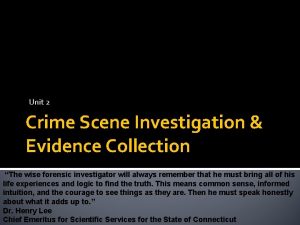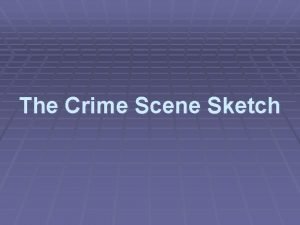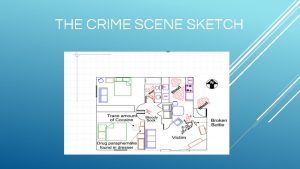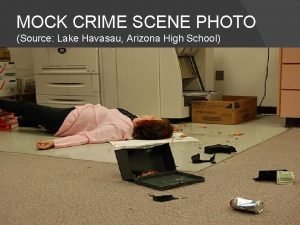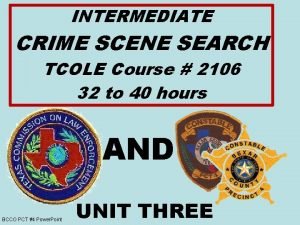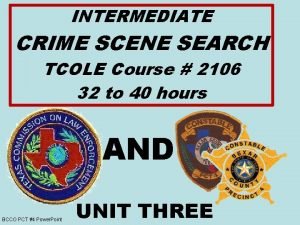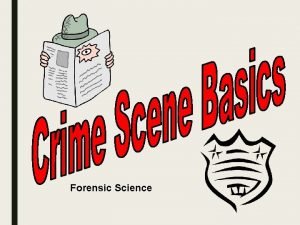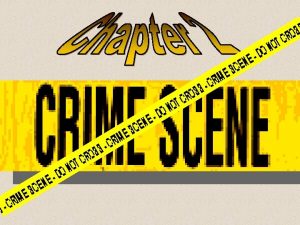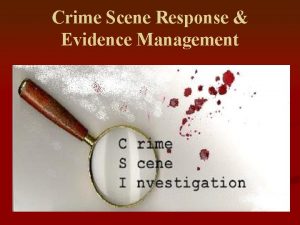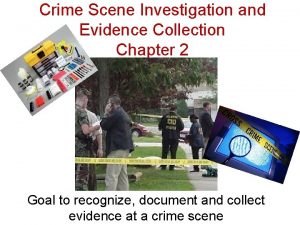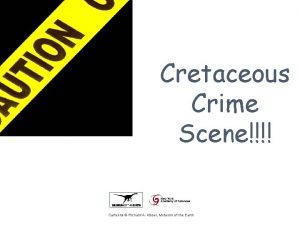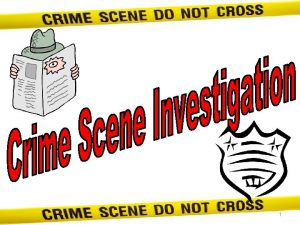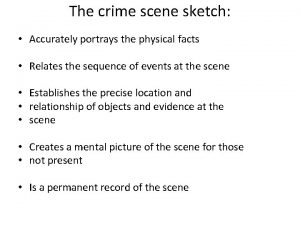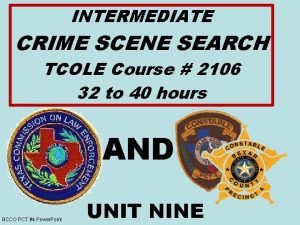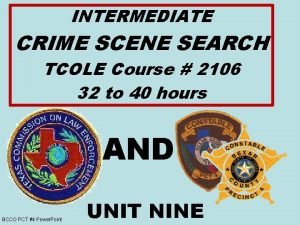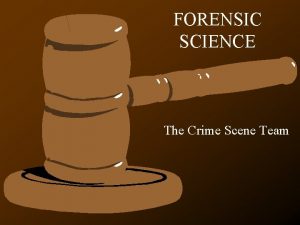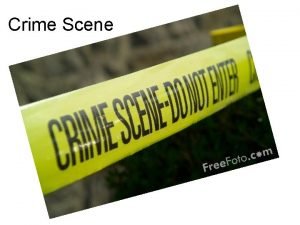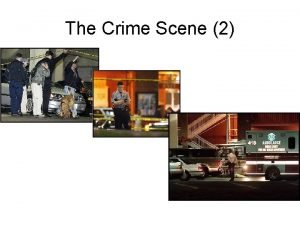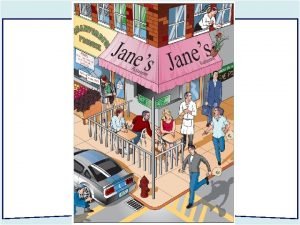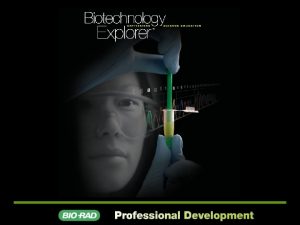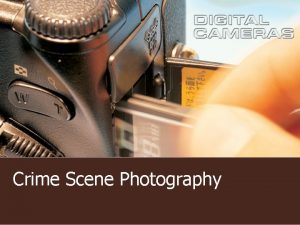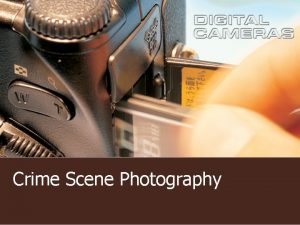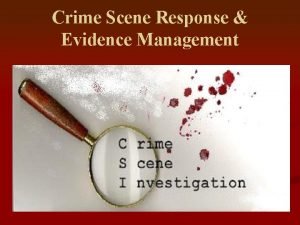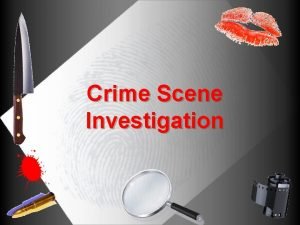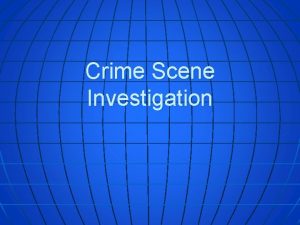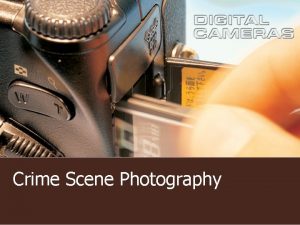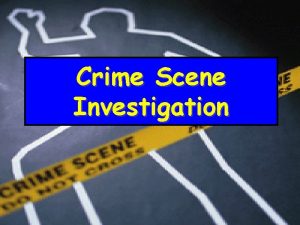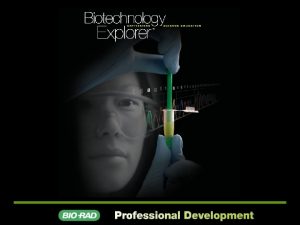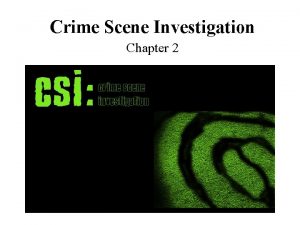The Crime Scene The Crime Scene Learning Goals









































- Slides: 41

The Crime Scene

The Crime Scene: Learning Goals • Define physical evidence • Discuss the responsibilities of the first police officer who arrives at the scene • Describe proper procedures for conducting a systematic search of a crime scene for physical evidence • Describe proper techniques for packaging common types of physical evidence

The Crime Scene: Vocabulary • • Buccal swab Chain of custody Finished sketch Physical Evidence Rough sketch Standard/Reference sample Substrate control

CSI: Crime Scene Investigation • Look for how the team analyzes the crime scene…

JONBENET RAMSEY: WHO DID IT? • Boulder, CO • Patsy & John Ramsey—wealthy Texas couple with 2 children (Burke, age 9 and Jon. Benet, age 6) • Jon. Benet was a child beauty pageant participant – Won many titles including America’s Royale Miss & Little Miss Colorado

JONBENET RAMSEY: WHO DID IT? • December 26 th, 1996 • Patsy Ramsey wakes to find a 2 ½ page note stating Jon. Benet has been kidnapped • The note demands a $118, 000 ransom of the Ramseys and advises them to not contact the police or friends and family • Patsy calls the local police at 5: 32 a. m.


JONBENET RAMSEY: WHO DID IT? • Police respond to the call and are at the Ramsey residence within 3 minutes • The house is not sealed off and only a cursory search of the house was done • Friends and the family’s minister is allowed to visit and console the Ramseys

JONBENET RAMSEY: WHO DID IT? • 1 p. m. —The house is more thoroughly searched for missing pieces of evidence • Jon. Benet’s body is discovered in a room of the basement with duct tape over her mouth, nylon cord binding her wrists and ankles, and a white blanket covering her torso • John Ramsey moves the body upstairs, compromising the crime scene in the basement


JONBENET RAMSEY: WHO DID IT? • Ample evidence supports theory that the crime was committed by an outsider, as well as competing evidence she was murdered by someone inside the household • Sept. 15 th, 1998—Grand jury convenes to discuss indicting the Ramseys, but could not meet the standard of proving guild • The Jon. Benet Ramsey murder is still an active investigation with the Boulder Police https: //www. youtube. com/watch? v=1 F 3 Ubv 2 cbds


Physical Evidence • Just as a car runs on gas, forensic labs run on physical evidence • Physical evidence is any object that can establish that a crime has or has not been committed or can link a crime to its victim or its perpetrator • Not every object within the vicinity of a crime is considered physical evidence

Preserving and Recording the Crime Scene • Evidence at the crimes scene must be preserved and recorded in as much detail as possible • Failure to secure the crime scene, preserve and record the scene could lead to destruction of evidence or misleading evidence

Secure and Isolate the Crime Scene • First officer on the Scene: – Give medical assistance for individuals that need it – Arrest perpetrator – Secure the crime scene (all unauthorized personnel need to be removed) • As more officers arrive, every effort should be made to isolate the area (ropes, barricades, yellow tape)

Secure and Isolate the Crime Scene • Every person that enters the crime scene has the potential to destroy physical evidence, even by accident • Once the scene is secure, the lead investigator must: – Determine the boundaries of the scene – Establish perpetrator’s path of entry and exit – Initial walk through of the scene to gain an overview of the situation and develop a strategy for examining/documenting the entire crime scene

Record the Scene: Photography • Crime scene must be UNALTERED • Objects must not be moved until they have been photographed from all necessary angles – Objects that are moved may be inadmissible in court • Photos from many angles can show possible lines of sight of victims, suspects, or witnesses

Photography • Photos are also important for documenting biological evidence in its original condition • Photos cannot stand alone, they must be supported by notes and sketches • CSIs use high resolution digital cameras to document crime scenes – Criticized because digital images can be easily manipulated

Photographic Procedures • Overview photos (including points of entry and exit) should be taken from multiple angles • If indoors, the entire room should be photographed to show each wall • If the crime scene includes a body, photos must be taken to show the position and location – Close ups depicting injuries and weapons lying next to the body are necessary

Photographic Procedures • As physical evidence is discovered, it must be photographed • At a minimum, 4 photographs must be taken: 1. 2. 3. 4. Overview photograph Medium-range photograph Close-up photograph with a scale (ruler)

Sketches • Once the scene is photographed, the investigators sketch the scene • A rough sketch is required during the early phase of an investigation – A rough sketch is a sketch, drawn at the crime scene, that contains an accurate depiction of the dimensions of the scene and shows the location of all objects having a bearing on the case – Contains distances that must be accurate (not guesses) taken with a tape measure – Items are assigned a letter – Should contain a compass heading designating north

Rough Sketch

Sketches • By the end of the investigation, a finished sketch should be presented • A finished sketch is a precise rendering of the crime scene, usually drawn to scale – Must reflect information within the rough sketch to be admissible in court – Computer-aided drafting (CAD) has become standard for reconstructing crime scenes from rough sketches

Final Sketch

Notes • Note-taking is a constant activity throughout the processing of a crime scene • Must include: – Identify the time the item was found – Who discovered it – How it was packaged – Who packaged it – Disposition of the item after it was collected • Written record may be the only source of information for memory, so they need to be as detailed as possible

Conduct a Systematic Search for Evidence • Even when suspects are immediately arrested and the motives and circumstances of the crime are apparent, a thorough search for physical evidence must be conducted • How the search is conducted depends on the locale and size of the area • The area searched must include all probable points of entry and exit used by the criminals

Search Patterns

Collecting Physical Evidence • Each clothing item should be handled carefully and wrapped separately to avoid loss of trace materials • Critical areas of the scene should be vacuumed – Sweepings from different areas must be collected and packaged separately • Fingernail scrapings from individuals who were in contact with others may contain minute fragments of evidence capable of linking the assailant to the victim

Collecting Physical Evidence • The search for evidence extends into the autopsy room – The coroner examines the victim to establish a cause and manner of death – Tissues and organs are kept for pathological and toxicological examination

Handling Evidence • Investigators must handle and process physical evidence to prevent any change from taking place between the time the evidence is removed from the crime scene to the time it is received by the lab • The use of latex gloves and disposable forceps can prevent changes – Any non-disposable equipment should be sanitized between collecting pieces of evidence • Evidence should remain unmoved until investigators have documented its location and appearance

Handling Evidence • Evidence maintains its integrity when left in its original condition – Should be submitted intact • Blood, hairs, fibers, soils, etc. on garments, weapons, etc. should be left alone and the whole thing should be sent to the lab

Packaging Evidence • Variety of materials and tools are used: – Forceps – Plastic/Metal pill bottles – Manila envelopes – Sealable plastic bags – Airtight containers for arson debris • Ordinary envelopes cannot be used – Powders/fine particles will leak out of the corners – “Druggist fold”

Packaging Evidence • Biological Materials – – – Blood, saliva, semen Use disposable containers only Non-airtight container Wrapping paper, manila envelopes, paper bags Red biohazard sticker • DNA Evidence – Should include anything victim/suspect contacted – Ex. stamps/envelopes, cups/cans, gum, sweatbands, bed sheets – Avoid contamination (introducing foreign DNA) • Coughing/sneezing on evidence during collection • Pieces of evidence are incorrectly placed with each other • Wear face mask, gloves, lab coat, etc.

Maintain Chain of Custody • Chain of custody—a list of all people who came into possession of an item of evidence • Failure to provide a chain of custody could call into question the authenticity and integrity of evidence • Physical evidence should be carefully packaged – If possible, it should be marked for identification – Collector’s initials and date of collection

Maintain Chain of Custody • Where appropriate, evidence is tagged for identification • Evidence containers should also be marked for identification – Initials, location, & date of collection • EVERY TRANSFER OF EVIDENCE SHOULD BE DOCUMENTED • Chain of custody should be kept to a minimum

Obtain Standard/Reference Samples • Examination of evidence requires comparison with a standard/reference sample – Physical evidence whose origin is known (e. g. blood or hair from a suspect), that can be compared to evidence • Reference samples can be collected from the victim, suspect, or other known sources • The presence of reference samples greatly helps forensic work – EX. hair from the scene and hairs from victims/suspects – Bloodstain evidence and buccal swab • Swab from the inner cheek; performed to collect cells for determining a DNA profile

Obtaining Standard/Reference Samples • Some evidence must also be accompanied by a substrate control – Uncontaminated surface material close to an area where physical evidence has been deposited – Normally collected at arson scenes – Tested to ensure that the surface doesn’t interfere with testing procedures

Submit Evidence to the Lab • Evidence should be submitted by personal delivery or mail – Postal regulations restrict shipment of certain chemicals, live ammunition, and explosives – In this case, evidence should be hand delivered by someone familiar with the case history • Most labs require evidence submission forms

Ensuring Crime Scene Safety • Bodily fluids must be treated as though highly infectious – Use caution and protection to prevent contraction of AIDs of hepatitis • CSIs use face masks for respiratory protection • Wear latex gloves, chemical resistant clothing, shoe covers, masks, goggles – Gloves should be changed often • When processing—be alert of sharp objects (knives, syringes, razor blades, etc. ) • NO EATING, DRINKING, GUM CHEWING on the scene

Systematic Search for Evidence • What to search for will be determined by the particular circumstances of the crime • Vehicle searches must be even more carefully planned out than any other search – Both the outside of the car and the undercarriage must be searched – Particular attention is paid to looking for evidence from cross-transfer between the car and the victim

Collecting and Packaging Physical Evidence • Physical evidence can be anything from massive objects to microscopic traces • Because of this, it is important to collect possible carriers of trace evidence in addition to obvious items
 Strategic goals tactical goals operational goals
Strategic goals tactical goals operational goals Strategic goals tactical goals operational goals
Strategic goals tactical goals operational goals General goals and specific goals
General goals and specific goals Examples of generic goals and product-specific goals
Examples of generic goals and product-specific goals Cuadro comparativo entre e-learning b-learning y m-learning
Cuadro comparativo entre e-learning b-learning y m-learning Christopher byers autopsy photos
Christopher byers autopsy photos What are the seven s's of crime scene investigation
What are the seven s's of crime scene investigation Types of crime scene
Types of crime scene Deanna schlosser
Deanna schlosser Final sketch crime scene
Final sketch crime scene Exploded cross projection sketch
Exploded cross projection sketch What must be included on a crime scene sketch
What must be included on a crime scene sketch Graphsketch
Graphsketch Sketching a crime scene
Sketching a crime scene Scene plan
Scene plan Tcole crime scene investigation
Tcole crime scene investigation Intermediate crime scene investigation #2106
Intermediate crime scene investigation #2106 Crime scene factoring and quadratic functions answer key
Crime scene factoring and quadratic functions answer key Oconnors bakery
Oconnors bakery Forensic science begins at the crime scene.
Forensic science begins at the crime scene. Crime scene sketching
Crime scene sketching Crime scene photography management
Crime scene photography management While the csi team is searching the crime scene, _____.
While the csi team is searching the crime scene, _____. Crime scene vocabulary
Crime scene vocabulary Cretaceous crime scene
Cretaceous crime scene Forensic crime scene sketch
Forensic crime scene sketch Crime scene vocabulary
Crime scene vocabulary A crime scene sketch should include
A crime scene sketch should include Spiral search method example
Spiral search method example Crime scene storyboard
Crime scene storyboard Robert pickton crime scene
Robert pickton crime scene Crime scene
Crime scene 2106 crime scene investigation
2106 crime scene investigation Corpus delicti
Corpus delicti Crime scene reconstruction definition
Crime scene reconstruction definition _____ is done with the first responding officer.
_____ is done with the first responding officer. Crime scene investigation background
Crime scene investigation background Crime clip
Crime clip Crime scene inference
Crime scene inference Criminal profiling serial killers
Criminal profiling serial killers Final sketch crime scene
Final sketch crime scene Crime scene notes
Crime scene notes






